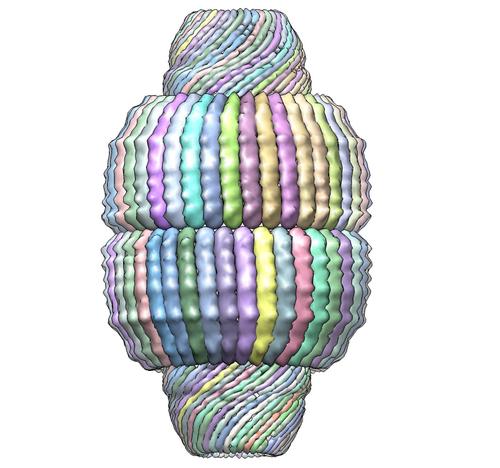A vault of knowledge: the weirdest and least studied cellular structure
by Tym Sokolskyi
If asked to list cellular organelles, many people will name mitochondria, ribosomes, the nucleus, or maybe chloroplasts or the Golgi apparatus – things they teach about in schools (though many people might not even remember learning about those). It seems perhaps that the age of breakthroughs in cytology is long gone, however, as many studies keep pointing out, we still do not know all that much about many of the diverse forms floating in our cytoplasm. One of these somewhat mysterious forms is called a “Vault”.
What are vaults?

In 1986, UCLA researchers, Dr. Nancy Kedersha and Dr. Leonard Rome, discovered what appeared to be strange dome-shaped particles while staining cells. They named these structures ‘vaults’ to reflect their similarity to the arches of cathedrals. They even created a website to educate the public about them. Vaults are very large particles – larger than some of the smaller viruses – that consist of two dome-shaped parts that can assemble together. Their outer shell consists entirely of a protein named MVP (Major Vault Protein). On the interior, two proteins can be found — vPARP, a poly-ADP ribose polymerase of unknown function, and TEP-1, a protein shared with the telomerase complex, an enzyme that extends the chromosome ends following cell division. In addition, there is a unique RNA molecule.
Despite being discovered in the former century, we still know very little about the functions and origins of vaults. They are relatively ubiquitous among eukaryotes — known from most animals, slime molds, and a variety of different protist clades. However, vaults are notably absent in several groups producing some of the most well-known model organisms — plants, fungi, and most ecdysozoans (arthropods and roundworms, nematodes). With this patchy distribution, vaults are surprisingly conserved indicating they might be performing or might have performed in the past a fundamental cellular function. This is further supported by homologs of MVP identified in multiple bacterial groups, including Cyanobacteria, Proteobacteria, and Bacteroidetes. Homology is a high similarity between two biological sequences that implies common ancestry, and studying homologs is usually key in determining evolutionary history of any structure. However, homology does not always indicate similarity of function and currently we have no idea what the function of vaults or bacterial MVP could be. Unfortunately, from the number of papers published about them in recent years, it seems that researchers may be losing interest in vault evolution.
What are they for?

While there is uncertainty, specialized functions have been proposed for some of the eukaryotic vaults. These functions largely include shuttling molecules inside the cell from one location to another. For example, vaults are associated with pores in the nucleus and import/export of proteins or RNA; signaling cascade scaffolding by connecting various signaling proteins together; axonal transport in neurons; some unidentified role in sea urchin development and multidrug resistance in human cells. These functions are highly diverse and do not allow us to piece together a cohesive picture of vault evolutionary origins.Only a handful of studies have dived deeper into vault evolution. In 2013, Toni Daly and colleagues using computational reconstructions of MVP predicted that it was likely ancestral in eukaryotes and present in LECA (the Last Eukaryotic Common Ancestor). These findings are odd in part because they prove that multiple eukaryotes lost vaults at some point in their evolution, at least in fungi, plants, and Ecdysozoa (oddly, only one arthropod is known to possess MVP – a velvet spider Stegodyphus). This scenario implies that there were specific selective pressures on the evolution of vaults in these groups, as opposed to a series of random horizontal gene transfers, further supporting the idea of vaults performing some major function.
A PhD thesis by A. A. Shaik in 2013 identified bacterial MVP homologs and also proposed a vault’s ancestral function – nutrient storage and sequestering, in addition to random regulatory processes that were known to be associated with vaults. This could explain their odd distribution – mostly in taxa that lost essential amino acid synthesis pathways and their upregulation during pathogen invasions. Surprisingly, they are entirely unknown from Archaea, ancestors of eukaryotes, or alpha-Proteobacteria, ancestors of mitochondria, which led the author to suggest they emerged in eukaryotes as a consequence of a gene transfer from a bacterial lineage. However, a lot more computational and laboratory research needs to be done on these particles and their bacterial relatives to fully grasp their role in the evolution of life and whether they were present in early organisms.
Answering these questions is not only important for furthering our understanding of origins of life but has practical ramifications as well. Multiple studies have explored the potential for vaults to be used as drug delivery vectors with promising results and their involvement in stress response pathways might have medical uses. Overall, we should certainly be learning more about this weird structure.
References
- Daly, T. K., Sutherland-Smith, A. J., & Penny, D. (2013). In silico resurrection of the Major Vault Protein suggests it is ancestral in modern eukaryotes. Genome biology and evolution, 5(8), 1567-1583.
- Frascotti, G., Galbiati, E., Mazzucchelli, M., Pozzi, M., Salvioni, L., Vertemara, J., & Tortora, P. (2021). The vault nanoparticle: A gigantic ribonucleoprotein assembly involved in diverse physiological and pathological phenomena and an ideal nanovector for drug delivery and therapy. Cancers, 13(4), 707.
- Kedersha, N. L., & Rome, L. H. (1986). Isolation and characterization of a novel 5ribonucleoprotein particle: large structures contain a single species of small RNA. The Journal of cell biology, 103(3), 699-709.
- Shaik, Asfa Alli. The unique phylogenetic distribution of vault particles reveals its functional roles. A thesis submitted for the degree of Doctor of Philosophy, Department of biological sciences, National university of Singapore 2013
Tym Sokolskyi was born in Kyiv, Ukraine and studied plant and evolutionary biology at Duke University, North Carolina and Kyiv National University, Kyiv. He is currently a first-year PhD student at University of Wisconsin-Madison Botany department.
